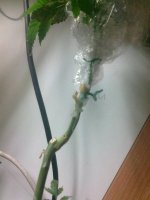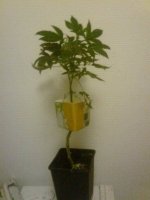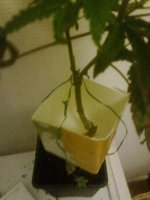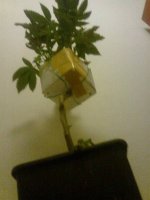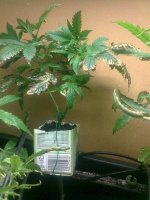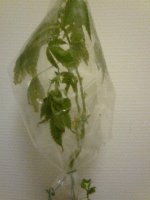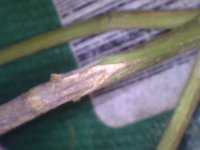You are using an out of date browser. It may not display this or other websites correctly.
You should upgrade or use an alternative browser.
You should upgrade or use an alternative browser.
Grafting Development
- Thread starter Apfel
- Start date
Im on for the ride!!
Very interesting.. I've always dreamed of a "Family Tree" style bonsai mother with four difffent stains, sadly indoor growing is on hold for the next 18 years while my kids grow up.
Im guessing that T-Budding would be too fidily to work for MJ but whip/tounge grafting would surley be a good start???

it's all about exposing the maximum amount of cambian tissue to each plant.. I'm sure grafting tape would also be a good investment.
Eggy
Very interesting.. I've always dreamed of a "Family Tree" style bonsai mother with four difffent stains, sadly indoor growing is on hold for the next 18 years while my kids grow up.
Im guessing that T-Budding would be too fidily to work for MJ but whip/tounge grafting would surley be a good start???

it's all about exposing the maximum amount of cambian tissue to each plant.. I'm sure grafting tape would also be a good investment.
Eggy
Im on for the ride!!
Very interesting.. I've always dreamed of a "Family Tree" style bonsai mother with four difffent stains, sadly indoor growing is on hold for the next 18 years while my kids grow up.
Im guessing that T-Budding would be too fidily to work for MJ but whip/tounge grafting would surley be a good start???

it's all about exposing the maximum amount of cambian tissue to each plant.. I'm sure grafting tape would also be a good investment.
Eggy
Eggy welcome and for those of you who don't know the attention to detail he has on things check out the F1 threads.
Have A Great Day
Mr.Wags
hi guys,
some stuff from today.
@big eggy
i tried that cutstyle and fixed the scion with wire and sealed it with usual candle wax. With my handycam i cant show you the cut, but it is really difficult to fix young limbs in this way. And that is my problem, i want to find a way to graft with young fresh limbs. anyway...
Chronic(C)whitewiddow

another small project i startet today
Euforia Plant

i fixed a box made from milk package and tape with wire...

....

and filled some light soil in and ...water

in 2 weeks there will follow a few cuts, and after they rooted well i will try to let this bucket dry out. I hope the roots of the stem will connect with the roots of the cuts.
just4 fun

some stuff from today.
@big eggy
i tried that cutstyle and fixed the scion with wire and sealed it with usual candle wax. With my handycam i cant show you the cut, but it is really difficult to fix young limbs in this way. And that is my problem, i want to find a way to graft with young fresh limbs. anyway...
Chronic(C)whitewiddow
another small project i startet today

Euforia Plant
i fixed a box made from milk package and tape with wire...
....
and filled some light soil in and ...water
in 2 weeks there will follow a few cuts, and after they rooted well i will try to let this bucket dry out. I hope the roots of the stem will connect with the roots of the cuts.
just4 fun

Attachments
singularity
Member
beautiful idea grafting MUILTIPLE strains, this surprisingly will hold more relevance than anything more obvious.
with proper grafting techniques you might suffer less loss. youtube a video or 2, there is always more to learn
with proper grafting techniques you might suffer less loss. youtube a video or 2, there is always more to learn
hey Apfel,
A great start either way you look at it.. Just to get any graft to take is a big thumbs up in my books. I guess this will be a lot of trial and error but I hope you stick at it as this is by far the most interesting thing i've seen in a while. There's a brief section in R C Clarke's book on grafting, i'll try and dig it out and send it to you. What are you using to make your cuts? A victorianox grafting knife might be a good investment.. Looked after it will hold a razor sharp edge.
Hey MrWagg's long time no see.. I've been in hiding for the winter.
A great start either way you look at it.. Just to get any graft to take is a big thumbs up in my books. I guess this will be a lot of trial and error but I hope you stick at it as this is by far the most interesting thing i've seen in a while. There's a brief section in R C Clarke's book on grafting, i'll try and dig it out and send it to you. What are you using to make your cuts? A victorianox grafting knife might be a good investment.. Looked after it will hold a razor sharp edge.
Hey MrWagg's long time no see.. I've been in hiding for the winter.
TheDillest
New member
haha the bucket suspended in the plant is a funny idea. I would have tried to root the cuttings first, in a separate container, then when they rooted filled the suspended pot with the mediue/root cuttings. Before filling the pot you would knick the stem of the host to provide access for the roots of the cuttings. Then let the medium dry out and hope for the best.
I'm also doing some work with grafting, just got started 3 days ago with it, so far I have 1 still holding on to life.
My main interest is the idea of grafting a fresh young female cutting onto the rootzone of an old harvested female plant. Recycling the rootball over and over indefinately and allowing it to get bigger with each season. The difficulty is finding a way to graft such a small cutting to such a large stem.
Good luck with your experiments
I'm also doing some work with grafting, just got started 3 days ago with it, so far I have 1 still holding on to life.
My main interest is the idea of grafting a fresh young female cutting onto the rootzone of an old harvested female plant. Recycling the rootball over and over indefinately and allowing it to get bigger with each season. The difficulty is finding a way to graft such a small cutting to such a large stem.
Good luck with your experiments
Sweet! I'm always looking for other growers playing with this technique!  Many thanks to Brother Bear for linking my other thread, as meager as it is.
Many thanks to Brother Bear for linking my other thread, as meager as it is.
Here's another thread, bit better documented than my flowering experiment.
https://www.icmag.com/ic/showthread.php?t=196218
After a bug problem, and resulting root rot, my grafted mother is still sick, and down to 2 strains from her former glory of 5 strains on 1 stem.
I'm tagging this thread for sure, if you have any questions about anything I did in the past feel free to ask. It's all about the sharing of information.
TheDillest; I've never tried to graft a scion to a harvested stem,.... not the worst idea. It certainly would give the scion a well developed root mass to feed it. The problem that I see with that is you'd have to leave enough of the host plant on her so she can survive and re-vege, and with the wild swing of hormones between the scion and the host I have my doubts the graft would take at all.
 Many thanks to Brother Bear for linking my other thread, as meager as it is.
Many thanks to Brother Bear for linking my other thread, as meager as it is.Here's another thread, bit better documented than my flowering experiment.
https://www.icmag.com/ic/showthread.php?t=196218
After a bug problem, and resulting root rot, my grafted mother is still sick, and down to 2 strains from her former glory of 5 strains on 1 stem.

I'm tagging this thread for sure, if you have any questions about anything I did in the past feel free to ask. It's all about the sharing of information.
TheDillest; I've never tried to graft a scion to a harvested stem,.... not the worst idea. It certainly would give the scion a well developed root mass to feed it. The problem that I see with that is you'd have to leave enough of the host plant on her so she can survive and re-vege, and with the wild swing of hormones between the scion and the host I have my doubts the graft would take at all.
hi,
Canniwhatsith, dillest, singularity, welcome here
@bigeddie, it seems so, that T-Budding might be a very good way to graft cuts. thxs again for you picture.
Generally there are few thinks very important for succesful grafting.
- use a small strong limbs with few leafs.
- make a very clean short und fast cut.
- connect the graft very fast und carefully to the stem
- use technics that expose the maximum amount of cambian tissue
- airtight the cut-surface (wax, cellotape or special graftiungfluid)
- airtight the hole graft as fast as possible,
- The amount of leaves should be 30% less, than usuall cuts.
- first 3 weeks humidity must be high as with usual cuts.
- temperature must be little higher than usuall- about 25-30 C.
- the first 3-5 days, bring the hole plant in a more shady place.
i think those are the most import rulez for grafting. Im still searching for more.
-------------------------
anyway...
there are a lot of ways to graft and im quitly shure, that grafting approach will be the easiest way to connect limbs.
A muliple mother in this style you can make in less than a month. So approach grafting is really a easy an 100% save method.
You dont need to look at any rules when you approach graft.
Just connect to woundet limbs, tape it or glue it together (airtight the connection!!). Wait for 3 Weeks and divorce as you like.
Thats it.
At the moment im still connecting grafts for my large projekt. 10 original plants, 10 multiplestrains an vs. them.
I know that approach grafting would be easy and works well, but i still have time till i can send to flower - new flat and so on..
So i still concentrate on the other types of grafting.
At roundabout 1. April i will send my plants to flower. So there is a lot time to make all this experiments in vegetation i always wanted to do.
Byside.
approach grafting is something for girls and cut-grafting for the freaks & real masculine man

haha
peace & cya
Canniwhatsith, dillest, singularity, welcome here
@bigeddie, it seems so, that T-Budding might be a very good way to graft cuts. thxs again for you picture.
Generally there are few thinks very important for succesful grafting.
- use a small strong limbs with few leafs.
- make a very clean short und fast cut.
- connect the graft very fast und carefully to the stem
- use technics that expose the maximum amount of cambian tissue
- airtight the cut-surface (wax, cellotape or special graftiungfluid)
- airtight the hole graft as fast as possible,
- The amount of leaves should be 30% less, than usuall cuts.
- first 3 weeks humidity must be high as with usual cuts.
- temperature must be little higher than usuall- about 25-30 C.
- the first 3-5 days, bring the hole plant in a more shady place.
i think those are the most import rulez for grafting. Im still searching for more.
-------------------------
anyway...
there are a lot of ways to graft and im quitly shure, that grafting approach will be the easiest way to connect limbs.
A muliple mother in this style you can make in less than a month. So approach grafting is really a easy an 100% save method.
You dont need to look at any rules when you approach graft.
Just connect to woundet limbs, tape it or glue it together (airtight the connection!!). Wait for 3 Weeks and divorce as you like.
Thats it.
At the moment im still connecting grafts for my large projekt. 10 original plants, 10 multiplestrains an vs. them.
I know that approach grafting would be easy and works well, but i still have time till i can send to flower - new flat and so on..
So i still concentrate on the other types of grafting.
At roundabout 1. April i will send my plants to flower. So there is a lot time to make all this experiments in vegetation i always wanted to do.
Byside.
approach grafting is something for girls and cut-grafting for the freaks & real masculine man


haha
peace & cya
Apfel excelent work and presentation. I failed at grafting last summer, I was trying to graft to Hops and outdoors in the hot summer temps. Bacteria I think was one of my problems. Cleanliness is mandatory as well as some humidity, which I lost all of, and the hot sun beating down on my graft surely didn't help any. They wilted with-in hours.
I might transplant a Hop start indoors and grow it out to maturity so I can try the graft under a more controlled environment someday...good luck with yours..rep to you buddy..DD
I might transplant a Hop start indoors and grow it out to maturity so I can try the graft under a more controlled environment someday...good luck with yours..rep to you buddy..DD
I was trying to graft to Hops and outdoors in the hot summer temps.
Hey DD was you tryinig to graft MJ to Hops? or just grafting Hops?
O
OrganicOzarks
Great thread.
Straight graft was once common practice with tomatoes , virus resistant rootstock .
Female tops will graft even onto spare male rootstock of a different cross , as long as the cross section of both stems matches closely , all three attempts unfortunately broke in mid flower as its a weak brittle graft in canna done this way.
Tomatoes butt grafted this way are more flexible and the crop weight rarely splits them.
Grafting Tomatoes
Why Graft A Tomato Plant?
If you prefer the taste of heirloom tomatoes, you know there's no going back to
most of the disease-resistant hybrids. But those hybrids grow so nicely. So take
advantage of that! Use them as the rootstock.
List of Materials
Heirloom tomato plant
Disease-resistant tomato plant
Gallon pot
Potting soil
4 stakes: These will protect the tomato from the plastic bag, so they should be about 6" taller than the grafted plant .
Clear plastic bag: This will cover the grafted plant and part of the gallon
pot. It should be at least 6" taller than the plant, and wide enough to
surround the plant without bending the leaves, as well as to go over the pot.
Razor blade or grafting knife
Rubber band large enough to go around gallon pot without effort
2 rubber bands or equivalent, very soft, 6" long: These will be used to tie
the graft union together, so they must be so soft that they can hold the
pieces together without bruising the stems. Cut the rubber bands once to
unloop them.
4 wire plant ties at least 6" long.
Choosing Which Plants To Use
Select a healthy heirloom at least 6" tall. You will cut it so you have about 4"
of stem on the cutting.
Choose a disease-resistant variety that grows really well in your site. Select a
tall, robust plant. At a height of at least 6", preferably more, the rootstock
plant's stem should be the same diameter as that of your heirloom's join point.
Note: I grow only indeterminate tomatoes, and I've always used indeterminate
plants for rootstocks. I have not tried using cherry tomatoes. I'd like to hear
about results using other kinds.
Key Ideas
You want to put an heirloom cutting with about 4" of stem onto a
disease-resistant rootstock, and you want the graft union to be high enough so
that there's rootstock stem to bury afterward. You want the diameters of the two
stems to be the same at the graft union. (This is where the two pieces are
joined.)
The two grafted pieces must be gently but firmly touching at all times. The two
pieces must not move, dry out, or get cold. The pieces must start off in optimal
condition.
When you plant the grafted tomato, no part of the heirloom should touch the soil
or mulch.
How To Go About It
Soak both plants for an hour.
Repot the rootstock in the gallon pot. Do not bury any of the stem.
Note the diameter of your heirloom at its join point, where you'll cut it.
Find the matching diameter on your rootstock.
At the leaf node just above the rootstock's join point, chop off the top of
the plant.
With the razor blade or knife, cut the top of the rootstock's stem into a V
shape. Begin the downward cut from the side of the stem. Make the cuts meet
cleanly in the middle of the stem. The angle of the two cuts should be around
20 degrees.
With the razor blade or knife, cut the heirloom's stem so that it exactly
fills the space in the rootstock's stem.
Position a stake so that the two pieces are perfectly aligned. Fit the two
pieces together, and tie them to the stake.
Wrap a soft rubber band very gently around the join and tie it. Use two if
necessary.
Poke three stakes into the outer edge of the gallon pot so that they prevent
the plastic bag from bending the plant's leaves.
Water the plant.
Put the plastic bag over the stakes and plant. Fasten it onto the gallon pot
with the big rubber band, by moving the rubber band up from the bottom of the
pot.
Put the plant in indirect light, where it's at least 65 degrees, and there is
no wind. Keep it there until you see new growth from the top. Do not let the
soil dry out.
Do not allow any growth from below the graft union.
When the grafted plant is growing, gradually remove the plastic bag over
several days. Begin by unfastening the bottom of the bag and leaving a space
between it and the pot.
If the top shows signs of wilting, put the bag back.
Remove the rubber band when the graft is established. The tops of the
rootstock will tend to splay apart if given the chance, so be sure there's new
tissue in the gap.
Gradually acclimate the grafted plant to full sun, over a few days.
When the graft is strong and acclimated, plant it out. Do not allow any part
of the heirloom to touch soil or mulch.
Female tops will graft even onto spare male rootstock of a different cross , as long as the cross section of both stems matches closely , all three attempts unfortunately broke in mid flower as its a weak brittle graft in canna done this way.
Tomatoes butt grafted this way are more flexible and the crop weight rarely splits them.
Straight graft was once common practice with tomatoes , virus resistant rootstock .
Most Tree brought from garden centres are grafted also.
It would be interesting to see what affect different root stocks have on the grafts.
with apple rootstocks they produce different affects on the grafted variaty, M27 producing a smaller tree and at the other end of the scale MM111 producing a monster.
Maybe just maybe a 100% sativa grafted to a compact indica might make the plant more managable..
or the other way round could produce a bigger than usual plant??
Just speculation but the root stock must add or take away some properties to the donner scion.
Keep up the interesting work Apfel you are surly going to uncover some interesting results.
BE
@ Eggy; to my knowledge the root mass won't effect the scion in any way.
After over a year the cuts I was taking from my grafted mum kept producing buds that were exactly like the original plant. and there is no difference in the growth of the shoots.
Also in my 1 flowering experiment, the scion still produced a bud that looked, smelled, and smoked like the donor, and not the host.
Here's a pic of the grafted joint after flowering, the Vanniluna stem is the purple, the host was an indica blueberry.
After over a year the cuts I was taking from my grafted mum kept producing buds that were exactly like the original plant. and there is no difference in the growth of the shoots.
Also in my 1 flowering experiment, the scion still produced a bud that looked, smelled, and smoked like the donor, and not the host.
Here's a pic of the grafted joint after flowering, the Vanniluna stem is the purple, the host was an indica blueberry.
Attachments
Also in my 1 flowering experiment, the scion still produced a bud that looked, smelled, and smoked like the donor, and not the host.
i really hope you are mistaken

So am I. Which is one of the reasons I'm really looking forward to your experiment here! 
It will be interesting to see if you get much variation between similar scions grafted onto various hosts.

It will be interesting to see if you get much variation between similar scions grafted onto various hosts.
Latest posts
-
-
-
question for sam the skunkman on the original haze
- Latest: AmericanFarmer
-
-
Latest posts
-
-
-
question for sam the skunkman on the original haze
- Latest: AmericanFarmer
-
-

